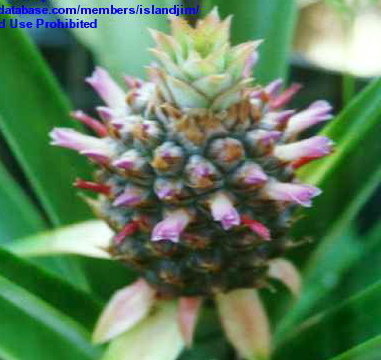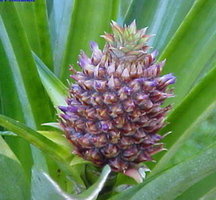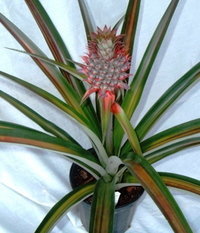





Kentucky is about as far inland as one can get, and there is not a thing tropical about us. About a year ago, I decided I wanted a pineapple plant. In a land where pineapples won't grow, I don't know where I thought I was going to get one. It wasn't like I could run to the nearest nursery and check their prices.
I love pineapples. Last year I happened across one that was exceptionally perfect. It was firm, sweet, juicy, and simply heavenly. It was so perfect I thought it should be cloned. I had just read an article by my fellow writer, JaxFlaGardener, known in real life as Jeremy Wayne Lucas. His article was so inspirational, as soon as I read it I was determined to grow my very own pineapple. So, having found the perfect pineapple, I saved it's top, I trimmed it, placed it in water, and about two weeks later it rooted! I planted it, took it outside for the summer and watched it grow. And grow it did. From that little sliced off crown, I now have 25 inches of pineapple plant growing in my den. And that, my friends, is something I could never find at a local plant nursery in this state. 
I have learned a lot about pineapples since I started nurturing this plant. You already know that I love to research the history of plants, and the pineapple is no exception. A long time ago my mother made the very best pineapple upside down cakes. I think maybe that is when my love affair with the pineapple began.
When you think of pineapples, you probably think of Hawaii. Most people assume the plant is native to the island, but pineapples originated in South America and probably did not reach Hawaii until early in the 19th century. The first record of their existence there is dated around 1813, after having been spread by Europeans across much of the world.
Columbus ran across them in about 1493 on the island of Guadeloupe. The natives there called them "ananas", and believed that they had been brought from the Amazon generations earlier. Actually, this might be correct because pre Incan burial sites have yielded pineapple shaped jars. When Columbus returned, he told Ferdinand and Isabella they resembled green pine cones, very sweet and delicious. He called the strange fruit "la pina de las Indias" which translated means the pine of the Indies. The strange name stuck and most Spanish speaking countries still call pineapples "pinas". Actually, the word pineapple originally meant "pine cone" in England.
The fruit was received well in Europe and was from there carried to India, Africa, China, and the East Indies, warm countries where the tender plants could reach maturity. It takes about a year and a half of a relatively frost free climate for the juicy fruit to form and ripen upon the 2 to 4 foot stem that rises from a rosette of stiff, spine edged leaves; there have been instances that proved that a few nights of 20 degree weather did not seem to hurt the plant. The fruit is actually a complex flowerhead that forms around the stem. An interesting thing about the pineapple, it is the only fruit whose main stem runs completely through it. Each of the "eyes" on the fruit's surface is the dried base of a small purple flower. The crown of leaves on top contains a bud, an d when this bud matures, the fruit is ready to be cut. Pineapples bear no viable seeds because they grow from the crowns.
d when this bud matures, the fruit is ready to be cut. Pineapples bear no viable seeds because they grow from the crowns.
The development of greenhouses in the 1700's made it possible for the upper class Europeans to grow their own pineapple plants. Since it was the wealthiest who had greenhouses, fresh pineapples soon became status symbols. Artisans began to decorate furniture with carved pineapples. Bedposts, ornate designs that framed mirrors, finials, and other furniture had the pineapple shaped carvings. Doorways, gateposts, and gables of homes in Europe and in the New World were adorned with pineapple carvings. I remember that my great grandparents had their home in Bardstown filled with such decorated furniture, and Gramma Ell always told me that the sign of the pineapple was a sign of welcome to a home.
Throughout its period of being a decorative design as well as a table delicacy, its medicinal qualities were all but forgotten. The Indians had used pineapple poultices to reduce inflammation in wounds and other skin injuries. In the latter part of the 19th century an enzyme called bromelain was isolated from the flesh of the pineapple and that enzyme breaks down protein. If you have ever wondered why your mother always baked ham with slices of pineapple on top of it, there you have your answer. It insured that the ham would be tender, the pineapple is a natural tenderizer. It is also a digestive aid. It can break down blood clots, (proteins are wha t hold blood platelets together to form clots), and it can also clean away the dead tissue left by burns, ulcers and various kinds of surgery.
t hold blood platelets together to form clots), and it can also clean away the dead tissue left by burns, ulcers and various kinds of surgery.
Since I have always thought pineapples came from Hawaii, it was surprising to find that it is not native to that state. So how did it get there? Spanish sailors carried the fruit on long trips to avert scurvy, and they could have left the leafy crowns to take root on many of the Pacific Islands. Actually the Spanish never reached Hawaii, but it would have been easy for a plant to have been taken from one island to another in the pacific. No matter how the plant got to Hawaii, the pineapple is now one of Hawaii's major crops. It is also the best known symbol of the island.
According to all I have read, it takes two years before the plant will bear fruit. I also found that it does not bloom until it reaches a height of 2 to 4 feet. Well now, mine has reached the magic number, and I don't really think it will bloom while it waits out this winter weather in my den, but maybe this summer there might be hope. Whether it ever blooms or not, it really is a lovely plant with it's dark green leaves and it's excellent upright posture. In the meantime, I think I will whip up one of Mom's pineapple upside down cakes.
If you would like to start your own pineapple plant, be sure to read Jeremy Lucas's article. It really was an inspiration to me.
It would not be fair for me to mention my mom's pineapple upside down cakes without giving her recipe, now would it? Here it is, I do hope you will enjoy one of my favorite desserts.
Pineapple Upside Down Cake
1 can sliced pineapple
1/4 cup melted margarine
2/3 cup packed brown sugar
maraschino cherries
1 pkg. yellow cake mix
Drain pineapple and reserve 3/4 cup juice
Stir together melted margarine and brown sugar in 12 inch skillet with heat proof handle. Arrange pineapple in sugar mixture. Place one cherry in center of each pineapple ring.
Prepare cake mix according to directions, replacing water with 3/4 cup of juice. Pour batter evenly on pineapple.
Bake at 350 for 40 to 45 minutes, or until toothpick inserted in center comes out clean.
Cool for 5 minutes. Loosen edges and invert onto serving platter.
Enjoy!
All photos are from PlantFiles. The photographers are Xyris, IslandJim, Vroomp, and Harmhahn.
Sources: http://en.wikipedia.org/wiki/Pineapple
http://www.hort.purdue.edu/newcrop/duke_energy/Ananas_comosus.htm
http://www.plantoftheweek.org/week119.shtml
(Editor's Note: This article was originally published on November 9, 2010. Your comments are welcome, but please be aware that authors of previously published articles may not be able to respond to your questions.)
Copyright © www.100flowers.win Botanic Garden All Rights Reserved